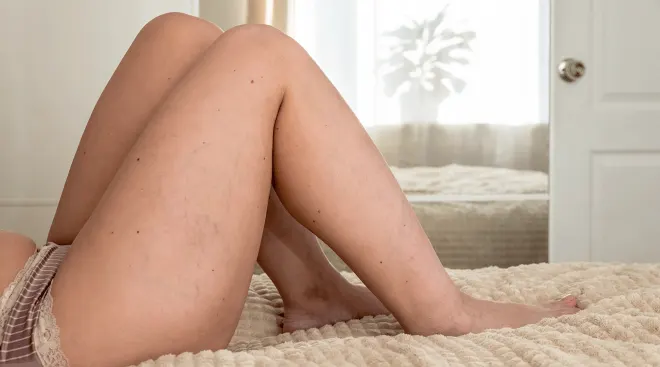Why Your Doctor Advises Against Eating Your Placenta After Birth
Thanks to celebrities and social media, in recent years, a surprising trend has emerged among laboring moms: eating the placenta following birth. Clinically known as placentophagy, this trend has become a practice more women are curious about as they prepare for delivery. But while some parents swear by the practice, many experts believe that eating placenta can pose a danger to Mom and baby. So is eating the placenta after birth safe? Read on to learn about the possible risks and potential benefits of eating placenta—and, of course, talk to your own doctor before deciding whether it’s the right option for you.
Before we dive into the benefits and risks of consuming the placenta, a quick refresher on what it actually is: It’s an organ that develops during pregnancy and attaches to the uterine wall. Baby stays connected to the placenta through the umbilical cord; it serves as their lifeline in the womb, carrying oxygen, nutrients and hormones to them, while carrying waste away. It also helps safeguard baby from harmful medications and infections.
The tradition of eating placenta has a long history. “The practice dates back centuries and is used in traditional Chinese medicine,” explains William Schweizer, MD, a clinical associate professor of obstetrics and gynecology at NYU Grossman School of Medicine. “Women have traditionally taken it after childbirth, during menstruation or during menopause,” he says, as placenta was thought to be restorative.
In fact, placenta-eating is a behavior commonly found in nature: Many animals, like deer and giraffe, consume their afterbirth. “Humans are actually the only mammal that doesn’t regularly eat their placenta after birth,” adds Rebekah Mustaleski, CPM, a certified professional midwife and compression director at Motif Medical. “For wild animals, it was the mother’s way of protecting her offspring. The young are always vulnerable, and leaving your placenta out can alert predators that there’s easy prey nearby.”
In the US, the practice of eating placenta emerged in the 1970s. “Some women began eating their placentas, like the mammals they saw in nature,” notes Mustaleski. It’s gained popularity in recent years, in part because celebrities like Kim Kardashian and January Jones have endorsed the practice, and because social media has made it easy for new moms to learn about placenta-eating and share their own experiences.
Theoretically, the placenta is an organ, so, like other types of organ meat (think duck liver, cow tongue, sweetbreads), it can be consumed. But is it safe to eat your placenta? The answer isn’t clear cut—and may vary depending on who you ask. According to Sherry Ross, MD, a women’s health expert and author of She-ology: The Definitive Guide to Women’s Intimate Health. Period., eating placenta after delivery may be harmful to your health, but it’s hard to be definitive, as “there’s limited scientific evidence showing its safety or possible risks when consumed.”
Mustaleski, however, says it’s most likely safe to consume the placenta if you had a healthy pregnancy and easy, uncomplicated delivery. “If you developed chorioamnionitis (an infection in the amniotic fluid), a uterine infection or if you regularly consumed alcohol or smoked during pregnancy then it wouldn’t be recommended to encapsulate your placenta,” she says.
All that said, the Centers for Disease Control and Prevention (CDC) advises against eating your placenta (more on why later!).
Before we get into the potential benefits and risks of eating placenta, it’s important to understand exactly how a placenta can be consumed after delivery. Usually the placenta is discarded by your care team following birth, Mustaleski says, so if you’re interested in having your placenta saved and prepared for consumption, it’s important to discuss it with your doctor during your pregnancy. It’s also important to make sure your hospital will let you take your placenta with you. “At our hospital, we allow mothers to bring their placenta home. We advise families to bring a cooler and remove their placenta within four hours,” Schweizer says—but that isn’t necessarily the policy at other hospitals. If you do choose to save your placenta, Mustaleski says to keep it in the fridge or in the freezer for up to six months after birth until you can have it encapsulated.
Eating placenta through encapsulation
You can consume placenta raw or cooked, but, if you’re going to do it, all experts recommend working with someone who’s experienced in preparing placenta instead of DIY-ing it yourself. If the placenta hasn’t been properly heated during preparation, there’s a higher risk of bacteria buildup, says Jules Gourley, founding member and director of the Association of Placenta Preparation Arts, a national placenta encapsulation training program. The most common approach to eating placenta is to have a professional service turn it into a specially prepared supplement through a process known as placenta encapsulation. “Placenta encapsulation uses food-safe methods to dehydrate and grind the placenta to a powder. This powder is then placed in capsules, which are then taken like any other supplement,” Gourley explains. “Some people choose to consume their placenta raw, but most people have their placenta steamed before it’s encapsulated,” Mustaleski adds.
While placenta encapsulation is considered the best way to consume placenta, even then there are risks. When working with a professional encapsulator, Gourley recommends doing some digging into their training and asking the following key questions:
How many hours have they spent learning about placenta encapsulation? What steps did they have to take to complete their certification? Are they self-taught?
Asking these questions will help you determine how the professional will be encapsulating the placenta and whether they’ll follow safety guidelines. And if you spike a fever or feel sick, or if baby gets sick, stop taking the pills and call your doctor right away.
The rise in placenta-eating is rooted in the belief that it can help moms ward off the baby blues and generally provide a healthy boost during the postpartum period. Ross and Mustaleski note the noted benefits of eating placenta are all anecdotal, but may include:
- Increased milk production
- More energy
- Reduced postpartum bleeding and faster postpartum recovery
- Reduced symptoms of postpartum depression and anxiety
- Balanced hormones
- Replenished nutrients in the body
- Better sleep
- Increased iron and nutrient supply in the body
“The placenta is known to be loaded with nutrients and iron,” Ross says, however, both she and Mustaleski emphasize there’s no conclusive evidence to support the beneficial effects of eating placenta after birth. “Research studies have provided us with mixed results about the benefits of consuming the placenta after birth,” Mustaleski agrees. “Some studies show that there are no differences in postpartum parents who consume placenta pills and those who don’t.”
The long and short of it is that while some moms rave about the benefits of eating placenta, science has yet to back up those claims. In fact, a Northwestern University review of the purported benefits found that eating placenta doesn’t boost a mom’s health in any way.
The lack of conclusive, research-based evidence is why many OBs are skeptical of the encapsulation process as a whole, and err on the side of caution that the risks may outweigh the rewards. “I’m always happy to discuss the encapsulation process with my patients, but scientifically I fail to believe there’s a benefit,” Schweizer says. “I’m a believer in prenatal vitamins and adding iron and vitamin C when the blood count after delivery is low. But if the process of placenta encapsulation is done quickly, and there’s no concern that the placenta is infected, then I don’t believe placenta encapsulation poses a risk of infection, and may have placebo benefits.”
If the placenta isn’t handled correctly, it can become contaminated with harmful bacteria or viruses, leading to a risk of infection for both Mom and baby. If you’re going to consume your placenta, understanding the possible dangers is key, Gourley says. For starters, it’s crucial that your placenta is prepared in a sterile environment or else blood-borne cross-contamination could occur. “The specialist should be trained in food-safe methods, have taken blood-borne pathogen training and have stringent sanitation methods,” she explains.
But even when the placenta is harvested by someone who’s experienced, Schweizer notes there are still cross-contamination risks during labor and delivery. Since birth isn’t a sterile process, bacteria from the birth process, including fecal bacteria, can contaminate the placenta and make you sick. “The vagina is an ecosystem with a multitude of bacteria and viruses,” Schweizer says. “The labor process can sometimes be prolonged, and infection can progress from vaginal bacteria into the placenta.” If the placenta isn’t quickly refrigerated and processed, bacteria can build up and the organ can spoil. In that case, raw consumption is definitely not advised, since it could lead to infection—but it’s important to know that even though cooked placenta is used for encapsulation, the process kills some but not all pathogens, he explains. And if a woman decides to eat placenta, doctors stress that she should eat only her own placenta; consuming another woman’s placenta may increase her risk of blood-related infections, including HIV or hepatitis, Schweizer says.
It’s important to keep in mind that the Centers for Disease Control and Prevention (CDC) warns against eating placenta—even when encapsulated. The org took this stance in 2016 after a newborn in Oregon contracted a group B streptococcus infection—not once but twice—from his mom, who was taking postpartum placenta pills. Babies typically get group B strep from their moms either during delivery or through breast milk, but in this case, the mom and her milk tested negative for the bacteria. After the infant was treated for the infection, doctors learned the mom had been eating placenta capsules, which came back positive for group B. Luckily, baby was discharged after a two-week hospital stay and an intensive round of antibiotics. Nevertheless, the org (and some experts) now advise against eating placenta in any form.
That said, a 2018 review from the University of Nevada, Las Vegas, found that eating placenta doesn’t increase risk of neonatal hospitalizations or death in the first six weeks of life.
Still, Mustaleski notes that even if you had an uncomplicated delivery, the placenta was harvested quickly and safely and encapsulated with food safety in mind, it still may not sit well with you. She shares that some clients have actually felt worse after taking encapsulated placenta rather than better, citing complaints of headaches and other side effects. Ultimately, like so many other aspects of pregnancy, the risks and benefits of eating the placenta are varied and personal.
According to Ross there aren’t really any safe alternatives to placenta encapsulation. But the main benefit of eating placenta is theoretically improved postpartum recovery—and there are lots of ways to give yourself a leg up without consuming your placenta. “The good news is you can still support your body in its postpartum recovery even if you aren’t sure about taking placenta pills,” Mustaleski says. “Good nutrition, adequate hydration, frequent naps and a support system to help you care for yourself, your baby and your home are the best things you can do to help yourself have a smooth and healthy postpartum recovery.”
If you’re still curious about eating placenta after birth or want to know other ways to boost postpartum recovery, Ross recommends consulting with your doctor. “Your healthcare provider can give personalized guidance and support based on your specific health needs and medical history.”
Please note: The Bump and the materials and information it contains are not intended to, and do not constitute, medical or other health advice or diagnosis and should not be used as such. You should always consult with a qualified physician or health professional about your specific circumstances.
Plus, more from The Bump:
Jules Gourley is a founding member and current director of the Association of Placenta Preparation Arts, a national placenta encapsulation training program.
Rebekah Mustaleski, CPM-TN, IBCLC, is a certified professional midwife specializing in evidence-based maternity care. She co-founded Roots & Wings Midwifery in Knoxville, Tennessee. Mustaleski received her bachelor’s degree in psychology from Centre College, and worked as a doula and birth photographer prior to establishing Roots & Wings.
Sherry A. Ross, MD, FACOG, is an ob-gyn with over 25 years of experience. She’s the author of She-ology: The Definitive Guide to Women’s Intimate Health. Period.. Ross obtained her medical degree from New York Medical College and spent her residency at the University of Southern California School of Medicine. She currently practices at Providence St. John’s Hospital in Santa Monica, California.
William Schweizer, MD, is a clinical associate professor of obstetrics and gynecology at NYU Grossman School of Medicine. She earned his medical degree from the State University of New York at Stony Brook and his master’s degree in public health from Yale University.
Animals, Consumption of Maternal Placenta in Humans and Nonhuman Mammals: Beneficial and Adverse Effects, December 2020
American Journal of Obstetrics and Gynecology, Human placentophagy: a review, April 2018
Northwestern Now (Northwestern University News), Eating The Placenta: Trendy But No Proven Health Benefits And Unknown Risks, June 2015
University of Nevada, Las Vegas News Center, Study: Maternal Placenta Consumption Causes No Harm to Newborns, May 2018
Centers for Disease Control and Prevention, Notes from the Field: Late-Onset Infant Group B Streptococcus Infection Associated with Maternal Consumption of Capsules Containing Dehydrated Placenta — Oregon, 2016, June 2017
Learn how we ensure the accuracy of our content through our editorial and medical review process.
Navigate forward to interact with the calendar and select a date. Press the question mark key to get the keyboard shortcuts for changing dates.





















































